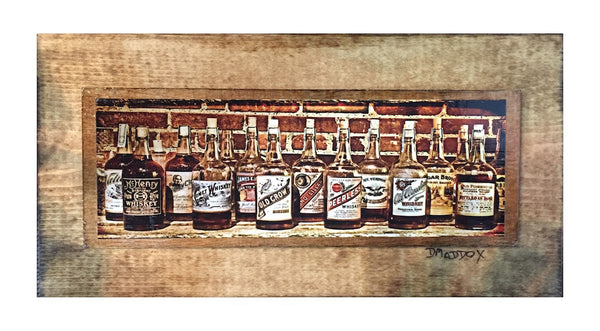The Relevance of Whiskey Art in Celebrating Heritage and Craftsmanship in the Beverage Sector
The complex partnership in between bourbon art and the event of heritage and workmanship within the drink industry can not be overstated. Via attentively created labels and containers, whiskey brands envelop their historic roots and the artisanal skills that specify their production approaches.
The Historic Roots of Whiskey
At the heart of bourbon's allure exists a rich tapestry of historical origins that trace back to old civilizations. The beginnings of whiskey can be connected to the distillation methods of the Sumerians and Babylonians around 2000 BCE, where early forms of fermented grain drinks began to arise. It was in the Middle Ages that the art of purification evolved considerably, especially in Ireland and Scotland, leading to the creation of scotch as we recognize it today.
The term "scotch" itself derives from the Gaelic word "uisce beatha," meaning "water of life." This phrase underscores the cultural value of bourbon in Celtic societies, where it was often connected with rituals, events, and public bonding. By the 15th century, distillation ended up being an identified craft within monastic communities, paving the method for the facility of legal distilleries.
As profession courses broadened, whiskey's popularity expanded, going beyond local boundaries and catching the rate of interest of connoisseurs worldwide. Realism Art. This historic journey reflects not just the workmanship behind whiskey production but also its important role in cultural and social contexts, marking it as a considerable beverage throughout background
Artistic Expression in Branding
Whiskey branding stands as an engaging crossway of virtuosity and business, where aesthetic identification plays a critical duty in forming consumer understanding. The visual appeals of bourbon tags, packaging, and advertising and marketing materials mirror not just the brand name's story but also its core worths and heritage. Via imaginative expression, distilleries communicate a narrative that reverberates with customers, evoking emotions and stimulating connections.
Using shade, typography, and images in branding serves to set apart items in a saturated market. For instance, conventional motifs may evoke a feeling of authenticity and workmanship, while modern layouts can signify advancement and forward-thinking. This tactical imaginative instructions boosts brand acknowledgment and loyalty, allowing customers to build an individual partnership with the scotch they choose.
Moreover, artistic expression in branding commonly acts as a celebration of local heritage. Distilleries often incorporate local symbols or historical references right into their styles, developing a local color that invites customers to take part in a more comprehensive social experience. Ultimately, the creativity behind bourbon branding not just enhances visual charm however likewise improves the overall narrative of the brand, promoting a deeper recognition for the workmanship and heritage ingrained in each container.
Craftsmanship in Bottle Layout
The virtuosity apparent in whiskey branding prolongs past visual identification to include the craftsmanship entailed in container layout. Each container offers as a vessel not just for the spirit within, yet additionally for the tale it outlines its beginning, high quality, and tradition. The design process requires precise interest to detail, as aspects such as closure, shape, and product add substantially to the total perception of the scotch.
Craftsmanship in container design entails selecting premium glass that can boost the bourbon's shade and clearness, while additionally offering a tactile experience for the customer. The silhouette of the container should be both functional and visually appealing, usually mirroring the heritage of the brand name. Many distilleries go with unique forms or printed logo designs that evoke a feeling of he said authenticity and history.
Additionally, the label design and typography play an essential duty in communicating the brand's story. Bourbon Art. A well-crafted bottle not just captivates the consumer's eye however likewise reinforces the brand's dedication to top quality and practice. By doing this, the workmanship of bottle style becomes an important element of the bourbon experience, combining artistry with an extensive respect for heritage
Cultural Relevance of Whiskey Art
Commemorating tradition and craftsmanship, the cultural significance of scotch art transcends simple looks, linking with the historic and social stories of the areas from which it stems. Each bottle offers as a canvas, portraying the distinct stories, folklore, and traditions that have actually shaped regional whiskey-making practices. The elaborate designs commonly mirror the heritage of the distillers, including signs and concepts that reverberate with the culture and values of their areas.

In addition, whiskey art plays a crucial role in communal celebrations and parties, offering have a peek here as a substantial web link between people and their shared experiences. By appreciating the virtuosity in scotch packaging, consumers grow a deeper understanding and respect for the craft, eventually improving their enjoyment of the beverage itself.
Modern Trends in Scotch Presentation
In recent times, the presentation of bourbon has actually progressed to reflect modern preferences and patterns while still honoring conventional craftsmanship - Bourbon Art. Distilleries are progressively concentrating on aesthetic components that boost the general drinking experience, connecting the space between heritage and modernity
Ingenious container layouts have emerged, typically integrating lasting materials and creative tags that tell engaging stories. Lots of brands now collaborate with local artists, instilling their items with unique aesthetic expressions that resonate with customers. In addition, limited-edition releases are frequently packaged in collectible containers, adding value and allure for connoisseurs.

Verdict
In final thought, scotch art offers as a vital channel for expressing the heritage and craftsmanship intrinsic in the beverage sector. Via detailed branding, cutting-edge bottle designs, and culturally substantial imaginative components, whiskey brands effectively recognize their customs and connect with consumers.


Workmanship in container design includes picking top quality glass that can boost check my reference the bourbon's shade and clarity, while additionally offering a responsive experience for the consumer. In this method, the craftsmanship of container style comes to be a vital facet of the whiskey experience, combining virtuosity with an extensive respect for heritage.
In final thought, whiskey art serves as an essential channel for sharing the heritage and workmanship inherent in the drink market.